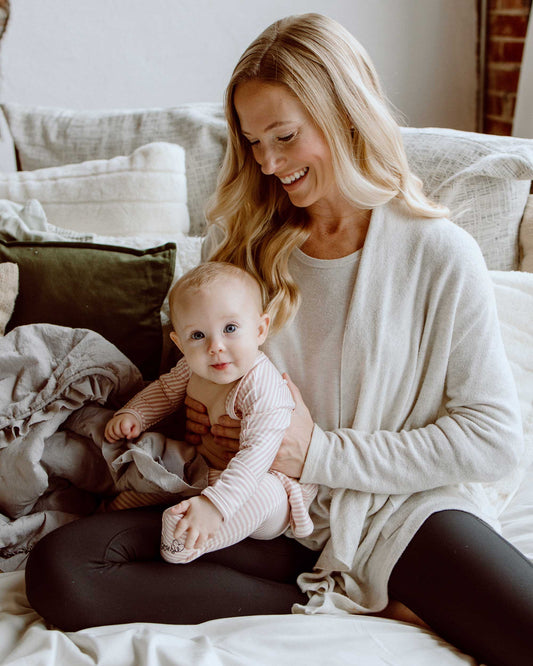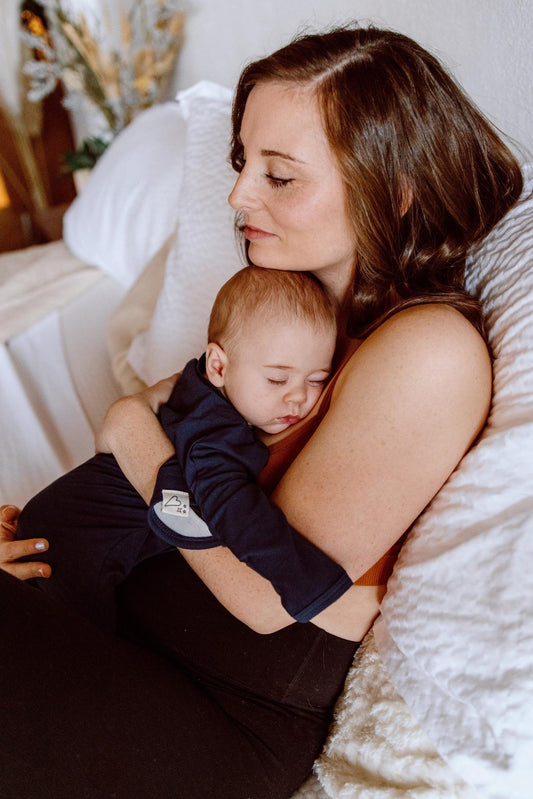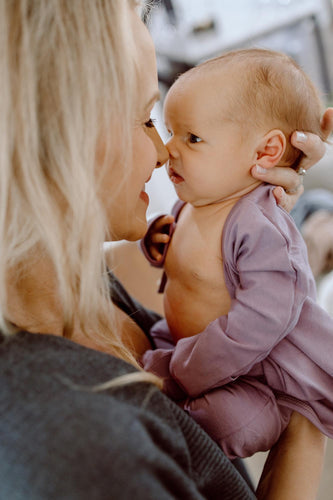Share
World Prematurity Day: Cassandra’s Story
Rohini MoreIn honor of World Prematurity Day and the 1 in 10 babies born prematurely, we’d like to share the birth story of Cassandra, a baby girl born at 32 weeks. Cassandra is the inspiration behind NICU Warriors, an Instagram account created to raise awareness about preemie babies, the NICU, and PostPartum Depression.

Cassie in the NICU
Amy Zaidman, Cassandra’s mother, was born and raised in New York where she currently lives with her husband and three daughters: Gabrielle is five-years-old, Cassandra is three-years-old, and Madilynn is three-months-old. Amy was a teacher before becoming a stay at home mom. Cassandra (Cassie) was born via c-section at 32 weeks after a high risk pregnancy. As a way to heal from the trauma of this experience and to support other parents, Amy created NICU Warriors.
Here is Amy’s story about her daughter, Cassie, and her social media platform that connects and empowers parents of fellow NICU Warriors:
“I found out I was pregnant with Cassie, my second child, in September of 2018. Things were going as expected until I was 16 weeks along. I went to the bathroom and saw blood; after going to my OBGYN and the hospital, it was confirmed that I had placenta previa. This meant my placenta was covering my cervix. For the next few weeks I was told my placenta would most likely move, but if it didn’t, I’d need a c-section. I began to have regular appointments with a Maternal Fetal Medicine (MFM) doctor to monitor this.
At 28 weeks I was in for a routine MFM appointment. The ultrasound technician suddenly left the room to go get the doctor. When they came back my doctor said, “this is a new one.” She had seen something on the ultrasound she had never seen before. There were unprotected blood vessels going across my cervix. I was diagnosed with Vasa Previa, as well as still having Placenta Previa. If I went into labor on my own, both my life and my baby’s life would be at risk due to the blood vessels being exposed and potentially rupturing.
When I hit 31 weeks exactly, I got admitted to the hospital and hemorrhaged. I wouldn’t be leaving for 17 days.
My daughter, Cassandra, was born on April 1, 2019, after another hemorrhage in the hospital. She was born at 32 weeks and 6 days via emergency c-section, at 4 lbs 5 oz, 17.5 inches. Right after an extremely traumatic birth, I quickly kissed her cheek and she was whisked away to the NICU. After 16 hours I finally met her. She was covered in more tubes and wires than I could have ever imagined. I could barely even see her face. I remember looking at her tiny, fragile body for the first time and having so many different emotions. I was so relieved that she was alive, (it took her about 10 seconds to cry at birth) but so terrified of what the future would hold.

Cassie, her father, Michael, and Amy in the NICU
The next morning Cassie developed a pneumothorax in her right lung. Her breathing struggles caused a rupture in her lung and air escaped, causing pressure in her chest. She had a tube inserted into the side of her chest. This tube allowed the air to escape and pressure to be relieved (she has a scar from this). She also had a brain ultrasound that day to make sure there wasn’t any brain damage.
I often refer to Cassie's 4th day of life as “the roller coaster”. I checked in with the NICU from my hospital room around 7:00 am and she was stable. About two hours later, my world was turned upside down. Someone knocked on my door and walked in, she introduced herself, but all I heard was “doctor from the NICU”. My heart sank to the floor. She told me that Cassie “decided to stop breathing” and had to be intubated. The machines were 100% breathing for her. Earlier that day she was getting 20 breaths per minute from the machines and now she was up to 380. To say I was inconsolable was an understatement. I was screaming. I was crying. I was shaking. I wanted to run to the NICU to go see her, but I was recovering from a traumatic c-section and could barely move at the time. When I finally got to see her, her belly was moving so fast from all the machines. The team of doctors came to meet with me and my husband.
My husband asked if she was going to survive this and nobody was able to give us an answer. It was up to Cassie.
Cassie was extubated a few days later and I was finally able to hold her. I was able to touch her. I was able to finally begin to bond with her.

Amy and Cassie finally get to be together
After 20 days of respiratory and feeding struggles, Cassie came home. She had lots of follow-up appointments with different specialists and doctors, and is now a happy and healthy three-year-old.
About a week after Cassie came home I found myself struggling mentally. I was quickly diagnosed with PTSD, postpartum depression, and postpartum anxiety. After about two years of therapy and medication I knew I was meant to share my story. I remember once asking my therapist, how will I know when I’m “healed”? She told me I’ll know when I use my story in a positive way. This is when NICU Warriors started on Instagram. This is what I am doing now. I want to educate others on prematurity and the NICU. I want to raise awareness and help others. Prematurity and NICU stays happen so frequently; it’s so important to have knowledge about it.

A current photo of Cassie, now three-years-old
As the mother of three, Amy knows all about the importance of skin-to-skin contact. However, due to Cassie’s premature arrival and medical complications, initial skin-to-skin contact was not possible.
“I wasn’t able to do skin to skin with Cassie during her time in the NICU. Having a full term birth before hers, I knew how special and important this was, since I had done it before. While Cassie had a chest tube and ventilator in, we weren’t able to really touch her, to keep everything in place.
Once everything got taken out, it was recommended by the hospital to do skin to skin for at least 90 minutes-2 hours at a time.
I had a two-year-old at home at the time, so it was hard for me to stay for long periods of time in the NICU. Between pumping around the clock and caring for my other daughter at home, it made doing skin-to-skin not possible. I wish I had gotten to do it while in the hospital, as I know how beneficial it would have been to both of us. I did, however, enjoy doing it when she finally came home.”
When medically possible, skin-to-skin care, often referred to as kangaroo care, is essential for the healthy development of premature babies. It regulates babies’ temperature, heart rate and breathing patterns. It also releases oxytocin, a hormone that improves breastfeeding success and leads to greater weight gain and attachment to the primary caregiver.
According to Sanford Health, “premature newborns who had prolonged skin-to-skin contact with their mothers while hospitalized actually had better survival odds. Since kangaroo care in South America originated, 124 studies around the world have confirmed its value for premature newborns throughout the world. Several studies showed that newborns who received standard medical care, as well as skin-to-skin contact, had a 36 percent lower death rate than those who only received standard care. These babies also had about one-half the risk of developing sepsis, were 78 percent less likely to develop hypothermia and were 88 percent less likely to have dangerously low blood sugar.”
The World Health Organization states that 15 million babies are born prematurely worldwide each year; one million do not survive. Premature birth is the leading cause of death in children under five. Three quarters of these deaths are preventable with the proper care and interventions.
During the month of November Bonsie Skin-to-Skin Babywear is donating 1% of every sale to an organization that works tirelessly to reduce premature births and improve infant and maternal health outcomes. Bonsie Skin to Skin Babywear is created specifically for skin-to-skin contact. Our mission is to promote this important practice and educate parents on the lifelong and life saving benefits.
Sources:
Preterm Birth. (2022, November 14). World Health Organization. https://www.who.int/news-room/fact-sheets/detail/preterm-birth
Seitz, J. (2017, July 18). The Importance of Skin-to-Skin with Baby After Delivery. Sanford Health News. https://news.sanfordhealth.org/childrens/the-importance-of-skin-to-skin-after-delivery-you-should-know/
Share
-
Category:
- All posts




